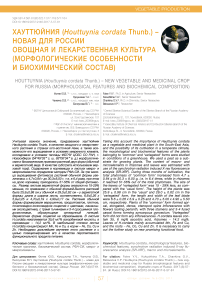Хауттюйния (Houttuynia cordata Thunb.) - новая для России овощная и лекарственная культура (морфологические особенности и биохимический состав)
Автор: Фотев Ю.В., Кукушкина Т.А., Чанкина О.В., Белоусова В.П.
Журнал: Овощи России @vegetables
Рубрика: Овощеводство
Статья в выпуске: 5 (38), 2017 года.
Бесплатный доступ
Учитывая важное значение, придаваемое хауттюйнии Hauttuynla cordata Thunb. в качестве овощного и лекарственного растения в странах юго-восточной Азии, а также возможности его выращивания в условиях умеренного климата, исследовали в условиях теплицы ФБГНУ ЦСБС СО РАН, г. Новосибирск (54°49'33" с. ш. 83°06'34" в. д.) морфологические и биохимические признаки растений двух форм (обычной и вариегатной) вида. В качестве субстрата использовали верховой торф. Содержание в корневищах и листьях макро- и микроэлементов определяли методом РФА-СИ. За три месяца выращивания фитомасса растений обычной формы увеличилась с 4,7±0,84 г до 30,3±8,00 г, т.е. в 6,4 раза, при этом на долю корневищ приходилось 51-56% от общей фитомассы. Размер листьев вариегатной формы оказался на 15-29% меньше, по сравнению с обычной формой. Высота растений была 25,9±0,98 см у обычной и 29,0±0,62 см - у вариегатной формы; длина и ширина листа, соответственно, 6,6±0,26 х 5,9±0,25 и 4,70±0,19 х 4,90±0,17 см. Растения обычной формы формировали верхушечное, продолговатое, плотное, початковидно-колосовидное соцветие с цветками, лишенными околоцветника, с тремя тычинками и 3-4 сросшимися плодолистиками, образующими синкарпный гинецей. Вариегатная форма соцветий не образовывала. В листьях H.cordata накапливается 35,6 мг/% аскорбиновой кислоты, в корневищах - 14,2 мг/%. В наибольшей степени листья H.cordata концентрируют Mn, Fe и Cu, а корни - Fe, Co, Cu и Zn. Необходимо дальнейшее изучение этого растения и с целью позиционирования его в качестве перспективного функционального продукта питания.
Хауттюйния, морфологические признаки, биохимический состав, рфа-си, макро- и микроэлементы
Короткий адрес: https://sciup.org/140223833
IDR: 140223833 | УДК: 581.4:581.6:582.622.1:577.118:577.164 | DOI: 10.18619/2072-9146-2017-5-57-61
Текст научной статьи Хауттюйния (Houttuynia cordata Thunb.) - новая для России овощная и лекарственная культура (морфологические особенности и биохимический состав)
В Юго-восточной Азии, особенно, в Японии и Китае, как нигде в мире понятия «продукт питания» и «лекарство» часто сливаются, формируя использование растений в качестве «лекарственной пищи» [1]. Среди ведущих лекарственных растений, использующихся в Юговосточной Азии в качестве овощных культур хауттюйния сердцевидная ( Houttuynia cordata Thunb.) или рыбья мята (кит.: Yu xTng cao - О?), относящаяся к семейству савруровые ( Saururaceae Rich. ex T.Lestib.), занимает особое место.
Вид распространен, преимущественно, в центральных, юго-восточных и юго-западных регионах Китая, в Японии, Корее и других странах Юговосточной Азии, где произрастает на увлажненных, затененных участках [2], на высоте от 300 до 2600 м [3]. В Японии рыбья мята – одно из ведущих лекарственных и пряно-ароматических растений, объем выращивания которого достигает 16100 кг (2002 год) [4]. Издавна в этой стране корни высушивали и использовали в лекарственных целях [5]. В китайской провинции Юньнань одна из групп тибето-бирманских народов (Shuhi) с давних пор использовала целые растения рыбьей мяты, включающие корневища, вместе с перцем чили [6]. Тибетцы, живущие в уездах Шангри-Ла и Вэйси этой же провинции КНР, обычно используют листья и корни хауттюйнии под названием «жерген» в свежем и обжаренном виде [7]. Во Вьетнаме рыбью мяту употребляют как салатное растение и в качестве лекарственной культуры [8]. В Бутане вид входит в число наиболее распространенных дикорастущих съедобных растений [9]. Для приготовления популярного здесь соуса Чатни молодые нежные листья и корни нарезают на небольшие кусочки, добавляя перец чили, лук, чеснок, имбирь и соль.
Houttuynia cordata Thunb ‒ единственный вид в роде Houttuynia Thunb. Число хромосом 2n=96 [10], хотя в разных популяциях встречаются цитотипы с 2n=72, 80, 96, 112 и 128 [11]. ISSR анализ большого числа образцов H.cordata, собранных в центральной, юго-восточной и юго-западной части Китая показал, что базальная группа состоит из популяций, происходящих из юго-западной части Китая, а остальные распределены равномерно и имеют тренд распределения на восток [2]. Структура генетического разнообразия популяций позволяет предположить, что вид, вероятно, сохранился в ледниковый период на юго-западе Китая и в дальнейшем распространялся в восточном направлении.
H.cordata ‒ многолетнее травянистое растение с тонкими шнуровидными корнями. Корневища расползаются горизонтально в поверхностном слое почвы. Высота растений 20-50 см, стебли красноватой окраски, несут очередно расположенные листья длиной 4-8 см и шириной 3-6 см, овально-сердцевидной формы [12]. Соцветие плотное колосо- видное, состоящее из 45-70 сидячих цветков [13]. Цветки мелкие, перигин-ные с 4 (реже 6-8) белыми прицветниками, напоминающими лепестки, тычинок 3, реже 4, пыльники 2-гнездные [14]. Высвобождаемая из пыльников пыльца представлена преимущественно монадами [15]. Пыльцевые зерна мелкие (размер 18-20 мкм), гетерополярные, билатерально-симметричные, ладьевидной формы, монокольпатные, апертура расположена на дистальном полюсе, с негладкой (рельефной) мембраной апертуры, тектум перфорированный. Цитологическое изучение H.cordata показало, что этот вид является полностью или почти полностью с мужской стерильностью [16]. Отмечены нарушения цитокинеза, приводящие к широкому варьированию формы и размера микроспор. Наблюдалась дегенерация микроспор.
Растение содержит флавоноиды и другие полифенольные соединения, пиридиновые алкалоиды, апорфин, органические и жирные кислоты, стеролы и микроэлементы [3]. Сообщается [3] о 346 летучих компонентах эфирного масла H.cordata. Основным его компонентом является 4-тридеканон [17]. Кроме того, во всех частях растения обнаружен основной ациклический монотерпен мирцен. В корневищах ‒ доминирующий монотерпен ‒ β -пинен. В этанольном экстракте целого растения общее содержание фенольных веществ ‒ 45,74 мг/г эквивалента таниновой кислоты, танинов 33,29 мг/г, флавоноидов 104,55 мг/г эквивалента рути-на[12].
Растение представляет собой потенциальный источник антиоксидантов и широко используется в народной медицине при лечении значительного числа болезней человека, таких как сердечнососудистые и онкологические заболевания, анемия, сахарный диабет, дизентерия и др. [18]. Исследованиями подтвержден антибактериальный эффект рыбьей мяты против паразитических видов грибов рода Trichophyton , бактерий из рода Staphylococcus Rosenbach и микобактерий туберкулеза. Недавнее исследование показало, что припарки на основе листьев Houttuynia cordat a с высокой эффективностью используют для лечения гнойных поражений кожи. Так, этанольный экстракт H.cordata проявил активный положительный эффект против Staphylococcus aureus , вызывающего гнойные заболевания кожи [19]. Содержащийся в рыбьей мяте кверцетин-3-рамнозид подавляет репликацию вируса гриппа серотипа A WS/33 в начальной стадии инфекции [20].
В исследовании стрептозоцин-инду-цированного диабета у крыс установлено, что этаноловый экстракт H.cordata в дозе 250 мг/кг может рассматриваться в качестве нового фактора при лечении этого заболевания, оказывающего также положительный эффект на функции печени [21]. Данные, полученные в КНР, показали, что фармакологическая эффективность этого растения про- является также при заболеваниях почек и респираторных проблемах [22]. Установлено, что экстракт листьев H.cordata подавляет возрастную гиперплазию простаты у мужчин [23]. В штате Аруначал-Прадеш на северо-востоке Индии измельченные части растения применяют для изгнания гельминтов из организма человека [24]. В этномеди-цинских практиках индийского штата Ассам листья этого вида представители народности Ахом с давних пор использовали для лечения дизентерии [25]. В Аргентине последователи китайской народной медицины широко используют рыбью мяту для улучшения когнитивных функций и в качестве адаптогена, а также в «анти-эйдж» терапии [26]. Есть данные [27] о хороших перспективах использования H.cordata для лечения ожирения. Экстракт H. cordata подавляет образование активных форм кислорода, вызванных поступлением бензопирена [28].
Анализ активности патентования в Великобитании, включающего генетические ресурсы, показал наличие патента на косметические и лекарственные средства в комбинации с H.cordata (патент US6280751B120010828: 31-33) [29].
В рыбоводстве эфирное масло из H. cordata проявило себя хорошим потенциальным стимулятором роста для рыбы и, вероятно, может заменить антибиотики при выращивании гибридной красной тиляпии ( Oreochromis mossambicus Linn. x Oreochromis niloticus Linn. ) [30].
В России хауттюйния – довольно распространенное декоративное растение. Среди садоводов популярна его пестролистная форма ‘Chameleon’, выращиваемая в том числе на юге Западной Сибири в открытом грунте (Новосибирская область.). Данный вид включен в состав эргазиофитов в Белоруси [31].
C учетом важного значения, придаваемого H.cordata в качестве овощного и лекарственного растения в странах юго-восточной Азии, а также возможности его широкого культивирования в условиях умеренного климата целесообразно оценить биохимический состав хауттюйнии с перспективой интродукции вида в России для получения функциональных продуктов питания.
Материал и методика
В качестве материала для исследования использовали форму H.cordata из провинции Юньнань (КНР) и местную декоративную вариегатную форму, выращиваемую садоводами в открытом грунте Новосибирской области. В качестве контроля использовали томат сорта Дельта 264 и огурец F1 Регина.
Растения выращивали в условиях теплицы ФГБУН Центрального сибирского ботанического сада СО РАН (ЦСБС СО РАН), г. Новосибирск (54°49′33″ с. ш. 83°06′34″ в. д.) в сосу- дах объемом 4 л на тепличном грунте, приготовленном на основе верхового торфа. Подкормки проводили один раз в три недели удобрением «Растворин» (марка 10-5-20-5) производства Буйского химического завода в концентрации 0,15% с расходом 0,5 л на сосуд.
Исследовали морфометрические признаки растений: высоту растений, длину и ширину листа, длину черешка, прилистника и междоузлий, диаметр корневища. Микроскопическое исследование структурных элементов соцветия и цветка выполнили с помощью электронного сканирующего микроскопа Hitachi TM-1000 (Япония).
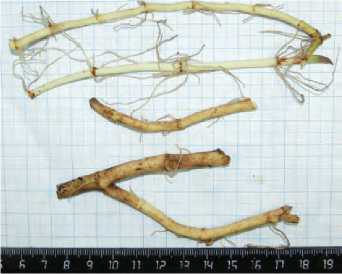
Рис. 2. Корневище H.cordata Thunb.
Статистическая обработка опытных данных выполнена стандартным способом [33].
Результаты
В период активного роста хаут-тюйния отличается интенсивным нарастанием зеленой фитомассы и корневищ. Так, за три месяца выращивания от посадки нарезанных побегов с корнями до развитых растений с мощными разветвленными корневищами в период с 28.07.17 по 25.10.17 их масса увеличилась с 4,7±0,84 г до 30,3±8,00 г, т.е. в 6,4 раза. При этом на долю корневищ приходится 51 – 56% от общей фитомассы.
Таблица 1. Морфометрические показатели растений двух форм H.cordata
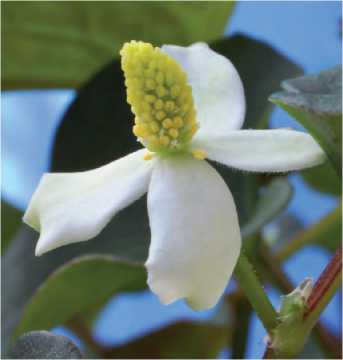
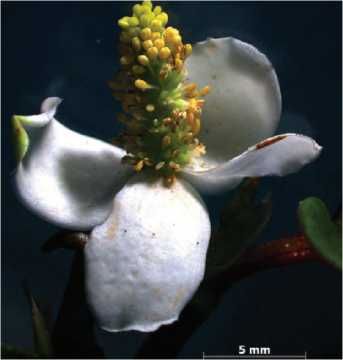
|
Формы |
||
|
обычная |
вариегатная |
|
|
Высота растений, см |
25,9±0,98 |
29,0±0,62 |
|
Длина листа, см |
6,6±0,26 |
4,70±0,19 |
|
Ширина листа, см |
5,9±0,25 |
4,90±1,17 |
|
Длина прилистника, см |
1,5±0,05 |
1,50±0,06 |
|
Длина черешка, см |
3,6±0,15 |
3,00±0,12 |
|
Длина междоузлия, см |
4,1±0,26 |
3,50±0,21 |
|
Диаметр корневища, мм |
3,8±0,23 |
3,19±0,20 |

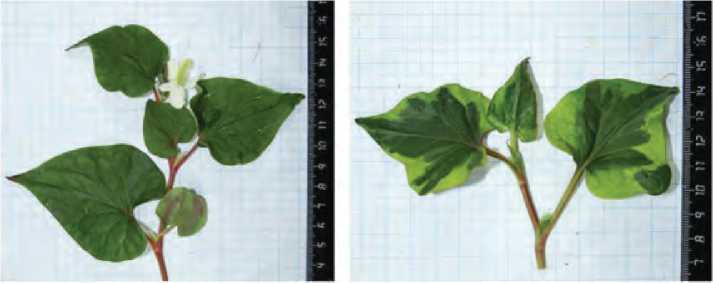
Рис. 1. Побег H. cordata Thunb., слева – обычной, справа – вариегатной формы.
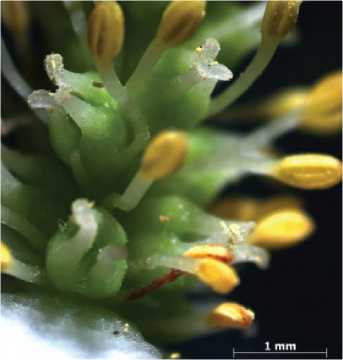
Рис. 3. Соцветие и цветки H.cordata.
овощи россии № 5 (38) 2017

Рис. 4. Микрофотографии частей цветка H.cordata: а – зачаточные цветки, б – завязь, в – часть пыльника с пыльцой.
Таблица 2. Содержание макро- и микроэлементов в фитомассе Houttuynia cordata Thunb., определенное методом РФА СИ, мкг/г
|
K Ca V Cr Mn Fe Co Cu Zn Br Rb Y Zr Nb Mo |
|
|
листья |
30690 15534 0,75 3,0 44,5 155,5 0,1 8,5 37,5 1,9 38,0 - 3,15 - 3,7 |
|
корни |
18508 5921 0,5 14,3 29 426 0,2 7,4 121 1,1 24,5 0,98 12,1 0,6 3,8 |
|
томат (плоды) |
30847 2727 0,03 41,5 7,8 38 0,03 1,7 18,5 4,4 4,3 н.о. 0,7 0,6 0,2 |
|
огурец (плоды) |
26668 4884 0,13 66,6 14,3 44,8 0,02 2,9 51,2 7,4 7,5 н.о. 0,95 1,76 0,81 |
Внешний вид побегов двух форм H.cordata и корневища показан, соответственно, на рисунках 1 и 2. Листья сердцевидной формы, с прилистниками, приросшими к черешку. Морфометрическая характеристика растений приведена в табл.1.
В сравнении с данными, полученными Kumar et al. (2014) [12], высота растений, размер листьев обычной и вариегатной формы рыбьей мяты в ЦСБС СО РАН входит в диапазон изменчивости значений для этого вида. При этом размер листьев вариегатной формы оказался на 15-29% меньше, по сравнению с обычной формой.
Цветение продолжалось в течение трех месяцев: с апреля до конца июня. Цветки у обычной формы H.cordata мелкие, лишенные околоцветника, с тремя тычинками, формирующие верхушечное, продолговатое, плотное, початковидно-колосовидное соцветие (рис. 3). Обертка соцветия венчиковидная, состоит из четырех лепестковидных, распростертых, яйцевидноэллиптических, белых прицветников, что делает соцветие похожим на отдельный крупный цветок, как у сложноцветных. Тычинок – 3, плодолистики в числе 3-4 штук, сросшиеся, образуют синкарпный гинецей. Вариегатная форма цветков не образовывала.
На микрофотографиях частей цветка H.cordata (рис.4) показаны зачаточ- ные цветки (а), завязь (б) и часть пыльника с пыльцой (в). На рис.4 (б) видны расположенные на завязи устьица.
Данные биохимического анализа, проведенного в ЦСБС СО РАН, показали, что листья H.cordata накапливают 35,6 мг% аскорбиновой кислоты, а корень – 14,2 мг% (сухого вещества в листьях 10,1%, в корневищах – 13,2%). Наши данные свидетельствуют о более высоком уровне накопления аскорбиновой кислоты в фитомассе растений вида, по сравнению с данными исследования, проведенного в КНР (7,92 мг%) [34].
Содержание элементов так называемого «кроветворного комплекса» [35] (Co, Cu, Fe, Mn) в листьях и корневищах рыбьей мяты оказалось в 2,911,2 раза более высоким, по сравнению с аналогичными показателями для плодов томата и огурца (табл. 2). Корни этого растения способны накапливать Zn в концентрации в 6,5 раз превышающей аналогичный показатель плодов томата. В наибольшей степени листья H.cordata концентрируют Mn, Fe и Cu, а корни – Fe, Co, Cu и Zn. Наши данные подтвердили результаты китайских исследователей [36] о резко выраженной способности рыбьей мяты накапливать Fe. При изучении в США минерального состава рыбьей мяты, специально выращиваемой в штате Калифорния хмонгами (этнической группой из Лаоса) в качестве приправы и лекарственного растения, также отмечено повышенное содержание в растении Fe, Mn, а также Mg [37].
Заключение
Хауттюйния отличается интенсивным нарастанием зеленой фитомассы и корневищ. За три месяца выращивания от посадки нарезанных побегов с корнями до развитых растений с мощными корневищами их масса увеличивается в 6,4 раза. При этом на долю корневищ приходится 51-56% от общей фитомассы. Размер листьев вариегатной формы оказался на 1529% меньше по сравнению с обычной формой. Анализ компонентов фитомассы хауттюйнии показал достаточно высокое содержание аскорбиновой кислоты в листьях (35,6 мг%) и среднее в корнях. Листья и корни этого растения накапливают значительное количество элементов кроветворного комплекса (Co, Cu, Fe, Mn) и Zn, превышающее показатели плодов традиционных культур – томата и огурца в 2,9-11,2 раза. Это может служить основанием к дальнейшему изучению этого растения и позиционированию его в качестве перспективного функционального продукта питания.
При подготовке публикации использовались материалы биоресурсной научной коллекции ЦСБС СО РАН «Коллекции живых растений в открытом и закрытом грунте», УНУ № USU 440534.
Список литературы Хауттюйния (Houttuynia cordata Thunb.) - новая для России овощная и лекарственная культура (морфологические особенности и биохимический состав)
- Chen J., Weng W. Medicinal food: the Chinese perspective//J.Med.Food. 2009. V.1, N2. P.117-122 DOI: 10.1089/jmf.1998.1.117
- Wei L., Wu X.-J. Genetic variation and population differentiation in a medical herb Houttuynia cordata in China revealed by Inter-Simple Sequence Repeats (ISSRs)//Int. J. Mol. Sci. 2012, 13, 8159-8170.
- Fu J., Dai L., Lin Z., Lu H. Houttuynia cordata Thunb: a review of phytochemistry and pharmacology and quality control//Chinese Medicine. 2013. V.4. P.101-123.
- Handa S. S., Rakesh D. D., Vasisht K. Compendium of medicinal and aromatic plants. Trieste, Italy: ICS-UNIDO. 2006. Vol. II. 296 p.
- Useful plants of Japan (described and illustrated). Vol. 1. Agricultural Society of Japan, Tameike I., Akasaka, Tokyo.1895. P.119.
- Weckerle C.S., Huber F.K., Yongping Y. et al. Plant knowledge of the Shuhi in the Hengduan Mountains, Southwest China//Economic Botany. 2006. V.60, N1. P.3-23
- Ju Y, Zhuo J, Liu B, Long C. Eating from the wild: diversity of wild edible plants used by Tibetans in Shangri-la region, Yunnan, China//Journal of Ethnobiology and Ethnomedicine. 2013;9:28 DOI: 10.1186/1746-4269-9-28
- Zeven A.C., Wet J.M.J. Dictionary of cultivated plants and their regions of diversity: excluding most ornamentals, forest trees and lower plants. Wageningen, Holland: Pudoc. 1982. P.63
- Tshering K., Thapa L., Matsushima K. et al. Edible wild plants of Bhutan and their contribution to food and nutrition security//In: Promotion of underutilized indigenous food resources for food security and nutrition in Asia and the Pacific/Edited by P.Durst, N.Bayasgalanbat: FAO Edition, Bangkok. 2014. P.60-69.
- Okada H. Karyomorphology and relationships in some genera of Saururaceae and Piperaceae//Bot. Mag. Tokyo. 1986. V.99. P.289-299.
- Oginuma K., Hisako S., Yoshiko K. et al. Intraspecific polyploidy of Houttuynia cordata and evolution of chromosome number in the Saururaceae//Chromosome Botany. 2007. V. 2, N 3. P 87-91.
- Kumar M., Prasad S.K., Laloo D., Joshi A., Hemalatha S. Pharmacognostical and phytochemical standardization of Houttuynia cordata Thunb.: a potent medicinal herb of North-Eastern India and China//Phcog J. 2014.V.6, N1. P.34-42.
- Tucker S.C. Inflorecsence and floral development in Houttuynia cordata (Saururaceae)//Amer.J.Bot. 1981. V.68. P. 1017-1032.
- Xia N., Brach A.R. Flora of China (Saururaceae). St. Lois: Science Press, Beijing and Missouri Botanical Garden Press. 1999. V.4. P.108-109.
- Lu L., Wortley A.H., Li D.-Z., Wang H., Blackmore S. Evolution of angiosperm pollen. 2. Basal angiosperms//Ann. Missouri Bot. Gard. 2015. V.100. P.227-269.
- Takahashi M. Microsporogenesis in a parthenogenetic species, Houttuynia cordata Thunb. (Saururaceae)//Botanical Gazette. 1986. V.147, N1. P.47-54
- Asakawa Y., Tomiyama K., Sakurai K., Kawakami Y., Yaguchi Y. Volatile compounds from the different organs of Houttuynia cordata and Litsea cubeba (L. citriodora)//J. Oleo Sci. 2017. P.1-7 DOI: 10.5650/jos.ess17049
- Rathi R.S., Roy S., Misra A.K., Singh S.K. Ethnobotanical notes on Houttuynia cordata Thunb. in North-eastern region of India//Ind. J. Nat. Prod. Res. 2013. V.4, N4. P. 432-435.
- Sekita Y., Murakami K., Yumoto H., Amoh T., Fujiwara N., Ogata S., Matsuo T., Miyake Y., Kashiwada Y. Preventive effects of Houttuynia cordata extract for oral infectious diseases//BioMed Research International. Volume 2016. ID 2581876, 8pages, http://dx.doi.org/10.1155/2016/2581876.
- Kapoor R., Sharma B., Kanwar S.S. Antiviral phytochemicals: an overview//Biochem. Physiol. 2017. V.6, N2. 7 pages; DOI: 10.4172/2168-9652.1000220
- Poolsil P., Promprom W., Chusri Talubmook C. Anti-hyperglycemic and anti-hyperlipidemic effects of extract from Houttuynia cordata Thumb. in streptozotocin-induced diabetic rats//Pharmacogn J. 2017. V.9, N3. P.382-387.
- Chang N., Luo Z., Li D., Song H. Indigenous uses and pharmacological activity of traditional medicinal plants in Mount Taibai, China//Evidence-Based Complementary and Alternative Medicine.V.2017. Article ID 8329817. 11 pages. https://doi.org/10.1155/2017/8329817.
- Koyama T. New botanical materials with anti-androgenic activity/In: Prostate Cancer -Original Scientific Reports and Case Studies/Ed.: Spiess P.E. InTech. 2011. P.193-206.
- Jeyaprakash K., Lego Y.J., Payum T., Rathinavel S., Jayakumar K. Diversity of medicinal plants used by Adi community in and around area of D’ Ering Wildlife Sanctuary, Arunachal Pradesh, India//World Scientific News. 2017. V.65. P.135-159.
- Bailung B., Puzari M. Traditional use of plants by the Ahoms in human health management in upper Assam, India//Journal of Medicinal Plants Studies. 2016. V.4, N2. P.48-51.
- Hurrell J.A., Puentes J.P. Plant species and products of the traditional Chinese phytotherapy in the Ciudad Autуnoma de Buenos Aires, Argentina//Ethnobiology and Conservation. 2017. V.6, N1. P.1 43
- Patra S., Nithya S., Srinithya B., Meenakshi S.M. Review of medicinal plants for anti-obesity activity//Translational Biomedicine. 2015. V. 6, N3. P.1-22.
- Doi K.; Mitoma C.; Nakahara T. et al. Antioxidant Houttuynia cordata extract upregulates filaggrin expression in an aryl hydrocarbon-dependent manner//Fukuoka Igaku Zasshi. 2014. V. 105. P. 205-213.
- Oldham P, Barnes C., Hall S. A review of UK patent activity for genetic resources and associated traditional knowledge. 2013. http://www.ip-watch.org/weblog/wp-content/uploads/2014/02/UK_IPGR_Full_Report_2013.pdf
- Wigraiboon S., Nakao P Nomura N.P., Whangchai N. Effect of essential oils from Houttuynia cordata Thunb supplemented diets on growth performance and immune response of Hybrid red tilapia (Oreochromis mossambicus Linn. Ч Oreochromis niloticus Linn.)//International Journal of Fisheries and Aquatic Studies. 2016. V.4, N3. P.677-684.
- Дубовик Д.В. Роль эргазиофитов в формировании флоры Беларуси//Сб.ст. 11-й Межд. науч.-практ.конф. «Актуальные проблемы изучения и сохранения фито-и микобиоты», 12-14 ноября 2013 г., Минск: Изд.центр БГУ. 2013. С.24-27.
- Ермаков А.И., Арасимович В.В., Ярош Н.П. и др. Методы биохимического исследования растений. Л.: Колос. 1987. 430с.
- Лакин Г.Ф. Биометрия. М: Высшая школа. 1990. 352с.
- Liu C., Zhao Y., Li X., Jia J., Chen Y., Hua Z. Antioxidant capacities and main reducing substance contents in 110 fruits and vegetables eaten in China//Food and Nutrition Sciences. 2014. V.5. P. 293-307.
- Круглов Д.С. Индивидуальная изменчивость элементного состава надземной части Pulmonaria mollis Hornem.//Химия растительного сырья. 2010. №1. С. 131-136.
- Zhi-xi G. Content determination of microelements and heavy metal in Houttuynia cordata by dry ashing atomic absorption spectrometry//Journal of Anhui Agricultural Sciences. 2009. N16. P. 7322-7323
- Corlett J.L., Clegg M.S., Keen C.L., Grivetti L.E. Mineral content of culinary and medicinal plants cultivated by Hmong refugees living in Sacramento, California//International Journal of Food Sciences and Nutrition. 2002. V.53, N2. P.117-128.

